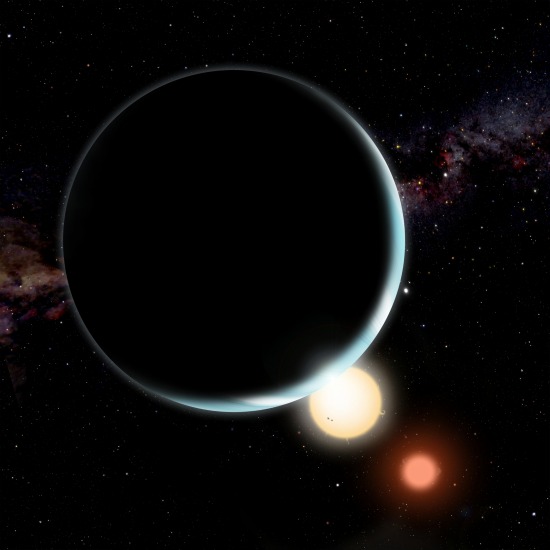The 5 Coolest Planets Orbiting Distant Stars
Of the hundreds of exoplanets discovered by scientists, we list of some of the most interesting
![]()

Kepler-16b, the exoplanet that orbits two different stars. Image via Harvard-Smithsonian Center for Astrophysics
Exoplanets—planets that orbit stars other than our own Sun—used to be the stuff of science fiction. Then, in 1992, astronomers spied one for the very first time. Now, at least 777 different exoplanets have been detected orbiting 623 different stars, and scientists project that as many as 160 billion exoplanets may exist in the Milky Way alone.
Researchers continue to detect these exoplanets at a rapid pace—since it launched in 2009, NASA’s Kepler space telescope has already help us find 74 confirmed planets and identify another 2,321 potential candidates—and we’ve discovered some truly fascinating ones so far. Here is a rundown of some of the most interesting and unusual:
1. GJ1214b, discovered last year, seemed like a typical exoplanet to astronomers at first glance. But when they tried to calculate the density of the supersized planet, with a diameter roughly 2.7 times that of Earth, they realized it was too light to be made up of rock—the planet had to be home to a remarkable amount of water. The “water” on this waterworld, just 40 light-years away, is not present in liquid form, but rather as steam or an exotic high-temperature ice that occurs only at extremely high pressures.
2. Kepler-16b is the closest thing we’ve found to Luke Skywalker’s home planet of Tatooine in Star Wars—it orbits not one star, but two. Discovered last year, the planet is relatively close to us, just 200 light-years away, and is a gas giant, similar to Saturn in both size and mass. Life on Kepler 16b, if it existed, would be truly strange: Every day would include two sunrises and two sunsets.

An infrared image of 2M1207b (the red ball at bottom left), the first ever exoplanet seen directly. Photo via European Southern Observatory (ESO)
3. 2M1207b is cool for a surprisingly obvious reason: We can actually see it. While the vast majority of exoplanets are detected indirectly–by the slight dimming of their star, which we see when the planet crosses in front of it–this exoplanet is enormous and close enough that we can directly image it using infrared light. 2M1207b also has a fascinating creation story: Unlike the planets in our solar system, which formed out of a disc of material left over from the formation of the Sun, 2M1207b seems to have formed out of the gravitational collapse of a separate, giant nebula sometime in the distant past.
4. WASP-12b won’t be with us much longer. The hottest exoplanet ever discovered (at roughly 4,000 degrees Fahrenheit) orbits so closely to its star that it is literally being consumed by the heat and pull of gravity. Since the planet was discovered in 2008, scientists have detected that it is gradually being pulled into an oblong, football shape by its star; they now estimate that it has some 10 million years left to live. Additionally, the planet is the first one discovered that is home to significant quantities of carbon, the essential building block for life as we know it.
5. Kepler-20e and Kepler-20f are extremely intriguing for one particular reason: The pair of planets, part of the same star system, both appear to be roughly the same size as Earth. Although they are far too close to their star to be capable of supporting life (their average temperatures are 1,400 and 800 degrees Fahrenheit, respectively), the planets may have migrated inward over time, indicating that they could have been home to extraterrestrial life sometime long ago. Reaching the Kepler system by space shuttle would take about 36 million years—but if we somehow made the journey, there might be some rather interesting fossils to find.
/https://tf-cmsv2-smithsonianmag-media.s3.amazonaws.com/accounts/headshot/joseph-stromberg-240.jpg)
/https://tf-cmsv2-smithsonianmag-media.s3.amazonaws.com/accounts/headshot/joseph-stromberg-240.jpg)